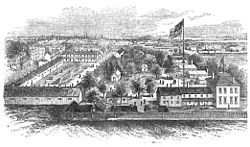History
George Hume Steuart (1700–1784) was an Edinburgh-educated physician, who settled in Annapolis in the Province of Maryland in c1721, where he established a medical practice. [1] [2] He married there, and became a tobacco planter, and politician.
Politically, Steuart's interests were closely aligned with those of the Calvert family, proprietors of the colony of Maryland. [3] In 1742 Charles Calvert, 5th Baron Baltimore (1699–1751) sent his eldest but illegitimate son, Benedict Swingate Calvert, then aged around ten years old, [4] to Annapolis and placed him in Steuart's care. [5] Steuart evidently benefited from the Calvert family's patronage, as he later was appointed to a number of important Colonial offices.
However, as a wealthy landowner with estates in both Maryland and Scotland, Steuart was forced by the outbreak of the American Revolution to decide whether to remain loyal to the British Crown or to throw in his lot with the American rebels. Unable to remain neutral, in 1775 he sailed to Scotland, where he lived until his death in 1784. [6] His sons however remained in Maryland, loyal to the fledgling United States of America.
Steuart's grandson, Major General George H Steuart (1790–1867) was a United States general who fought during the War of 1812. His military career began in 1814 when, as a young captain, he raised a company of Maryland volunteers, the Washington Blues, leading them at the Battle of Bladensberg and the Battle of North Point, where he was wounded. [7] After the war he rose to become major general of the Maryland Militia. In 1861, at the start of the Civil War, Steuart left his home state of Maryland, which stayed in the Union, and joined the Confederacy, though at 71 he was too old for active service.
During the American Civil War Maryland remained loyal to the Union, but the Steuarts were substantial slaveholders and supported the Confederate States of America. On April 16, 1861 George H. "Maryland" Steuart, then an officer in the United States Army, resigned his commission as captain to join the Confederacy. [8] Much of the family's property was confiscated by the Federal government due to their supporting the Confederate Army. Old Steuart Hall was confiscated by the Union Army and Jarvis Hospital was erected on the estate, to care for Federal wounded. [9] The family's wealth and status never recovered.
A number of less-known Steuarts also joined the rebel states. Among them was the surgeon William Frederick Steuart. [10]
Modern Legacy
The unusual spelling of "Steuart" was widespread in the 18th century ("Steuart", "Stewart" and "Stuart" being essentially interchangeable), but has since mainly fallen into disuse. However, Steuart's numerous North American descendants have retained the archaic spelling.
A silver replica of the original Annapolis Subscription Plate was commissioned in 1955 by the Maryland Jockey Club. The "Dungannon Bowl" is a perpetual trophy presented to the winner of annual Dixie Stakes, the oldest stakes race run in Maryland and the Mid-Atlantic states. [22]
A stone obelisk at Dodon marks the burial place of Richard Sprigg Steuart and a number of other family members. Brigadier General George H. Steuart and his father Major General George H. Steuart are both buried beneath a family obelisk at Green Mount Cemetery, Baltimore, [23] and The Steuart Hill area of Baltimore recalls the family's long association with the city. [24]
This page is based on this
Wikipedia article Text is available under the
CC BY-SA 4.0 license; additional terms may apply.
Images, videos and audio are available under their respective licenses.











